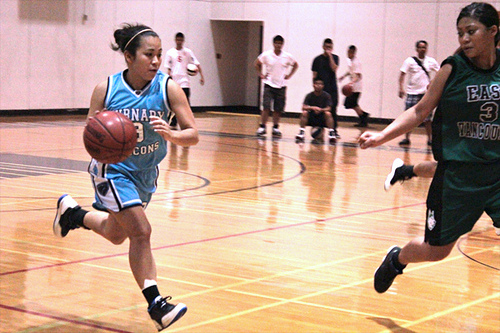How to Dribble a Basketball


When teaching players How to Dribble a Basketball there are some core instruction points to help with the uptake of the skill. Instructing players in how to dribble a basketball if approached focusing too much on the fundamental movements will only confuse, delay development and can have effect of disenchanting a players enjoyment of the game.
To help in teaching a young player (or novice player) the skill of dribbling a basketball focus on the few points below.
Control the Ball with the Finger Tips
When players first start in their attempts to dribble a ball, it is often seen that they slap at the ball. This is often caused by a player trying to put force into the ball and allowing their palm to make contact with the ball instead of controlling the ball with their fingertips.
In attempting to increase the power when dribbling, if the ball makes contact with the palm of the hand it can actually rob the player of the desired force and control. As a player’s hands strengthen and they become slightly more coordinated they will find the technique of using their fingertips much more beneficial in dribbling.
Dribble the Ball at Hip Height
Bouncing the ball to high and it becomes slow and difficult to control. Dribble the ball too low and this increases the degree of difficulty in trying to manage control of the basketball. When teaching a player how to dribble the ball emphasis must be placed upon keeping the basketball at hip height while dribbling.
This height is very useful as it allows a player to also be comfortable when dribbling the ball so initially they can learn the dribbling technique by simply walking and dribbling.
Keep the Ball in the Dribbling Pocket
We a player is adding movement while dribbling the ball, it is not uncommon for their feet to get in the way. This is really about ball control and keeping the appropriate space between the body and the ball. However, another vital element which will help is if the player is able to master keeping the ball in the dribbling pocket.
The dribbling pocket is an imaginary position in line with the toes but outside the feet. This means a player can walk, or run without ever having the fear of kicking the ball because it is always outside the line of where the foot will be moving.
Head Up, Eyes Looking Ahead
It is not uncommon when first teaching a player how to dribble the basketball for the player to struggle in not looking at the ball. This is probably the single biggest issue facing players and hampers development significantly. An emphasis needs to be placed on a player keeping their head up or they will stall in their development very quickly.
Vision is what provides a player with the ability to anticipate what the defence is doing, where space is on the court, as well as where their teammates are. All of these elements are a direct benefit from a player having good vision while being able to control the ball.
Working slowly through these points with a new player learning how to dribble a basketball will provide the best results. Dribbling forms the core triangle of offensive skills with shooting and passing that a player must master to enjoy the sport as much as possible. Using simplified games that promote good vision are a fantastic way of keeping all the skills of dribbling in play, while adding the final and often most challenging task.

